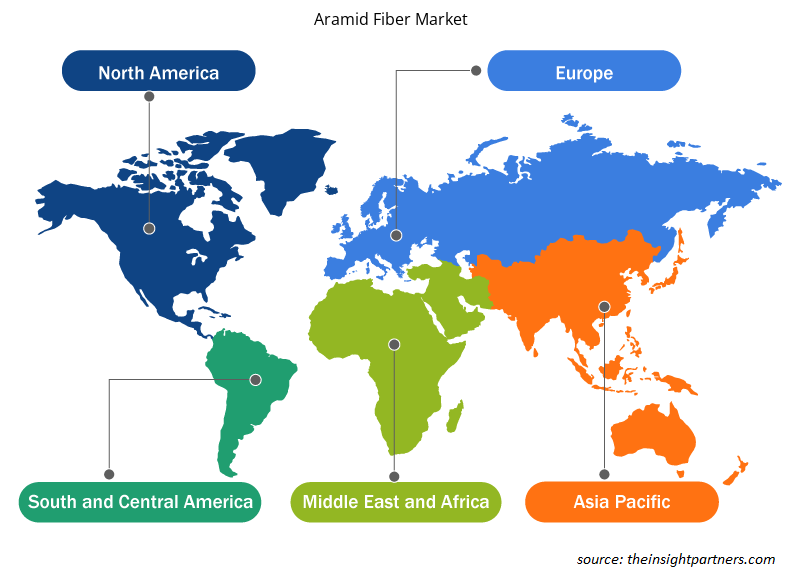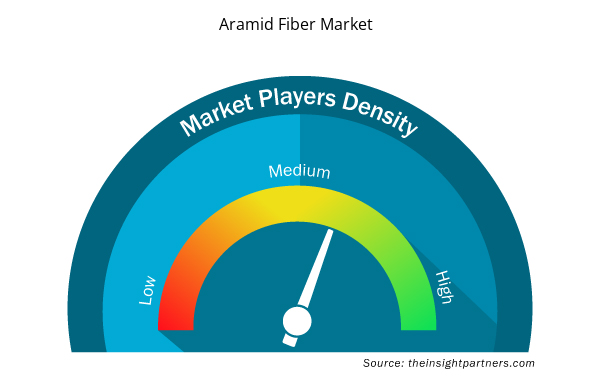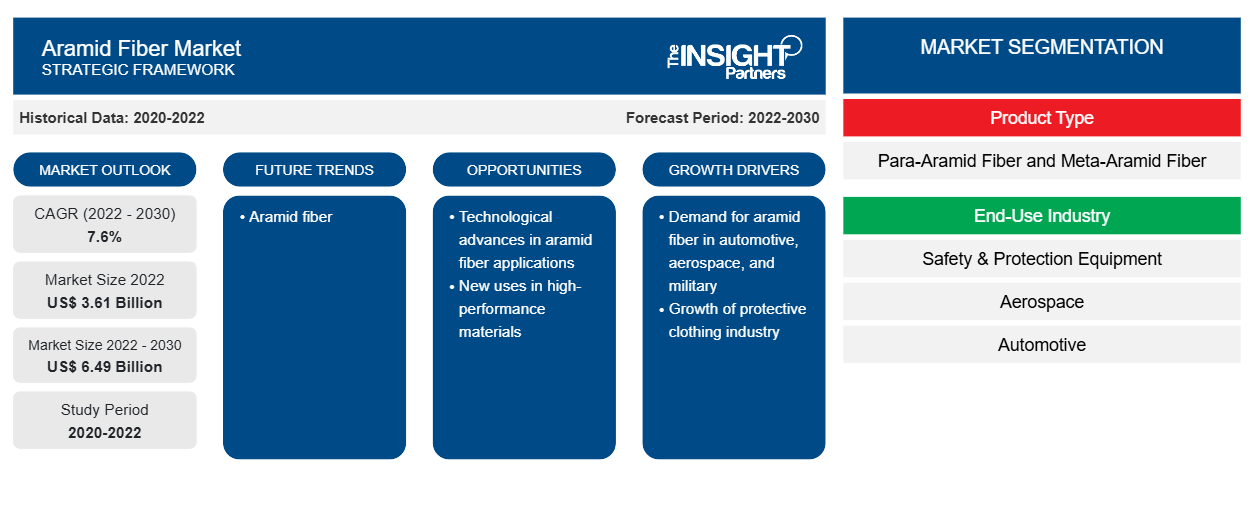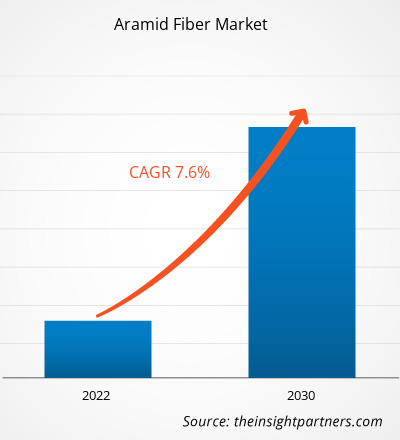[Rapporto di ricerca] Nel 2022 il mercato delle fibre aramidiche ha raggiunto i 3,61 miliardi di dollari USA e si prevede che raggiungerà i 6,49 miliardi di dollari USA entro il 2030; si stima che registrerà un CAGR del 7,6% dal 2022 al 2030.
Approfondimenti di mercato e opinioni degli analisti:
Le fibre aramidiche, note anche come poliammidi aromatiche, sono fibre sintetiche con eccezionale resistenza, resistenza al calore e durevolezza. Sono rinomate per la loro elevata resistenza alla trazione, che è da cinque a sei volte maggiore di quella dell'acciaio, e per la loro natura leggera, essendo solo un quinto del peso dell'acciaio. Queste notevoli proprietà rendono queste fibre preziose per un'ampia gamma di applicazioni, in particolare nei settori che richiedono elevate prestazioni e sicurezza. La struttura unica delle fibre aramidiche contribuisce in modo significativo alle loro eccezionali proprietà. Queste fibre sono costituite da lunghe catene di molecole di poliammide, dove i legami ammidici sono direttamente collegati ad anelli aromatici. Questa disposizione si traduce in una struttura rigida, simile a un'asta, che conferisce notevole resistenza e rigidità alle fibre. Inoltre, gli anelli aromatici forniscono intrinseca resistenza al calore e stabilità, consentendo a queste fibre di resistere ad alte temperature senza degradazione significativa.
Fattori di crescita e sfide:
La crescente domanda da parte dell'industria automobilistica è stata una delle principali forze trainanti dietro l'espansione del mercato delle fibre aramidiche . La domanda di queste fibre è aumentata esponenzialmente poiché i produttori di automobili si sono sempre più concentrati sulla produzione di veicoli più leggeri e più efficienti nei consumi. L'elevato rapporto resistenza/peso di queste fibre, in particolare le varianti para-aramidiche, tra cui il Kevlar, consente lo sviluppo di componenti leggeri senza compromettere l'integrità strutturale. Nel settore automobilistico, queste fibre sono ampiamente utilizzate in varie applicazioni, tra cui la produzione di pneumatici, freni, pastiglie e materiali compositi. Il rinforzo di questi componenti con queste fibre ne aumenta la durata e la resistenza all'usura, contribuendo a una maggiore durata e a prestazioni complessive migliorate. Inoltre, queste fibre sono utilizzate nella produzione di compositi per autoveicoli, fornendo un equilibrio tra resistenza e peso cruciale per raggiungere gli obiettivi di efficienza nei consumi. Pertanto, tutti questi fattori stanno guidando la domanda di fibre aramidiche nel settore automobilistico.
Il mercato delle fibre aramidiche, tuttavia, deve far fronte a limitazioni nella crescita dovute alla disponibilità di sostituti che offrono proprietà simili o alternative. La fibra di carbonio è uno dei principali sostituti di queste fibre, che condivide alcune caratteristiche con le fibre aramidiche, tra cui elevata resistenza e proprietà leggere. In alcune applicazioni, i produttori possono optare per la fibra di carbonio come alternativa, soprattutto quando cercano materiali con rigidità o conduttività superiori. Questa concorrenza da parte dei sostituti pone una sfida all'adozione diffusa di queste fibre, in particolare nei settori in cui entrambi i materiali potrebbero potenzialmente soddisfare le specifiche richieste.
Personalizza questo report in base alle tue esigenze
Riceverai la personalizzazione gratuita di qualsiasi report, comprese parti di questo report, o analisi a livello nazionale, pacchetto dati Excel, oltre a usufruire di grandi offerte e sconti per start-up e università
- Scopri le principali tendenze di mercato in questo rapporto.Questo campione GRATUITO includerà analisi di dati che spaziano dalle tendenze di mercato alle stime e alle previsioni.
Segmentazione e ambito del report:
"Global Aramid Fiber Market Analysis to 2030" è uno studio specializzato e approfondito con un'attenzione particolare alle tendenze di mercato e alle opportunità di crescita in tutto il mondo. Il rapporto mira a fornire una panoramica del mercato con una segmentazione dettagliata del mercato per tipo di prodotto e settore di utilizzo finale. Il mercato ha assistito a una crescita elevata nel recente passato e si prevede che continuerà questa tendenza durante il periodo di previsione. Il rapporto fornisce statistiche chiave sul consumo di fibra aramidica a livello globale. Inoltre, il rapporto fornisce una valutazione qualitativa di vari fattori che influenzano le prestazioni del mercato della fibra aramidica a livello globale. Il rapporto include anche un'analisi completa dei principali attori del mercato e dei loro principali sviluppi strategici. Sono incluse anche diverse analisi sulle dinamiche di mercato per aiutare a identificare i principali fattori trainanti, le tendenze di mercato e le opportunità redditizie che, a loro volta, aiuterebbero a identificare le principali sacche di entrate.
L'analisi dell'ecosistema e l'analisi delle cinque forze di Porter forniscono una visione a 360 gradi del mercato, che aiuta a comprendere l'intera filiera e i vari fattori che incidono sulla crescita del mercato globale delle fibre aramidiche.
Analisi segmentale:
In base al tipo di prodotto, il mercato è suddiviso in fibra para-aramidica e fibra meta-aramidica. In termini di settore di utilizzo finale, il mercato è segmentato in dispositivi di sicurezza e protezione, aerospaziale, automobilistico, elettronica e telecomunicazioni e altri. Il segmento dei dispositivi di sicurezza e protezione ha registrato una quota di mercato significativa delle fibre aramidiche nel 2022. Le fibre aramidiche, in particolare le varianti para-aramidiche come il Kevlar, sono rinomate per la loro eccezionale resistenza, l'elevato modulo e la resistenza agli urti, rendendole ideali per applicazioni in cui sicurezza e protezione sono fondamentali. Questa fibra è ampiamente utilizzata nella produzione di giubbotti antiproiettile e caschi. L'intrinseca resistenza balistica di queste fibre, unita alla loro natura leggera, le rende una scelta preferita per i giubbotti antiproiettile. Le agenzie militari e delle forze dell'ordine in tutto il mondo utilizzano ampiamente dispositivi di protezione a base di aramide per fornire al personale una protezione efficace contro le minacce balistiche senza compromettere la mobilità. Tutti questi fattori stanno guidando il mercato delle fibre aramidiche per il segmento dei dispositivi di sicurezza e protezione.
Analisi regionale:
In base alla geografia, il mercato delle fibre aramidiche è segmentato in cinque regioni chiave: Nord America, Europa, Asia Pacifico, Sud e Centro America e Medio Oriente e Africa. Il mercato è stato dominato dall'Asia Pacifico, che ha rappresentato circa 1 miliardo di dollari USA nel 2022. La regione comprende un ampio numero di opportunità per la crescita del mercato. Anche i crescenti investimenti diretti esteri portano alla crescita economica nella regione. Si prevede che il crescente utilizzo di queste fibre in numerose applicazioni, tra cui parti di automobili, elettronica e altre, aumenterà la domanda di fibre aramidiche nell'Asia Pacifico.
Si prevede che l'Europa registrerà un CAGR di oltre l'8,0% dal 2022 al 2030. Le fibre aramidiche sono essenziali per la produzione di componenti leggeri ma robusti nelle strutture degli aeromobili e nei sistemi di protezione balistica. Poiché l'Europa ospita importanti aziende aerospaziali e un importante settore della difesa, la domanda di fibre aramidiche in questi settori continua a crescere. Inoltre, si prevede che il Nord America raggiungerà circa 1,7 miliardi di dollari nel 2030.
Sviluppi del settore e opportunità future:
Di seguito sono elencate le varie iniziative intraprese dai principali attori operanti nel mercato delle fibre aramidiche:
- Ad aprile 2023, DuPont de Nemours Inc. ha annunciato il lancio della fibra aramidica Kevlar EXOTM. Kevlar EXO offrirà una combinazione di leggerezza, flessibilità e protezione dalla fibra aramidica, con la protezione della vita come primo di molti casi d'uso.
Approfondimenti regionali sul mercato delle fibre aramidiche
Le tendenze regionali e i fattori che influenzano il mercato delle fibre aramidiche durante il periodo di previsione sono stati ampiamente spiegati dagli analisti di Insight Partners. Questa sezione discute anche i segmenti e la geografia del mercato delle fibre aramidiche in Nord America, Europa, Asia Pacifico, Medio Oriente e Africa e America meridionale e centrale.

- Ottieni i dati specifici regionali per il mercato delle fibre aramidiche
Ambito del rapporto sul mercato delle fibre aramidiche
| Attributo del report | Dettagli |
|---|---|
| Dimensioni del mercato nel 2022 | 3,61 miliardi di dollari USA |
| Dimensioni del mercato entro il 2030 | 6,49 miliardi di dollari USA |
| CAGR globale (2022-2030) | 7,6% |
| Dati storici | 2020-2022 |
| Periodo di previsione | 2022-2030 |
| Segmenti coperti | Per tipo di prodotto
|
| Regioni e Paesi coperti | America del Nord
|
| Leader di mercato e profili aziendali chiave |
|
Densità degli attori del mercato: comprendere il suo impatto sulle dinamiche aziendali
Il mercato delle fibre aramidiche sta crescendo rapidamente, spinto dalla crescente domanda degli utenti finali dovuta a fattori quali l'evoluzione delle preferenze dei consumatori, i progressi tecnologici e una maggiore consapevolezza dei vantaggi del prodotto. Con l'aumento della domanda, le aziende stanno ampliando le loro offerte, innovando per soddisfare le esigenze dei consumatori e capitalizzando sulle tendenze emergenti, il che alimenta ulteriormente la crescita del mercato.
La densità degli operatori di mercato si riferisce alla distribuzione di aziende o società che operano in un particolare mercato o settore. Indica quanti concorrenti (operatori di mercato) sono presenti in un dato spazio di mercato in relazione alle sue dimensioni o al valore di mercato totale.
Le principali aziende che operano nel mercato delle fibre aramidiche sono:
- DuPont de Nemours Inc
- Teijin limitata
- Azienda di materiali avanzati Yantai Tayho
- Società Hyosung
- Società Toray Industries Inc.
Disclaimer : le aziende elencate sopra non sono classificate secondo un ordine particolare.

- Ottieni una panoramica dei principali attori del mercato delle fibre aramidiche
Impatto del COVID-19:
La pandemia di COVID-19 ha avuto effetti negativi su quasi tutti i settori in vari paesi. I lockdown, le restrizioni di viaggio e le chiusure delle attività in Nord America, Europa, Asia Pacifico (APAC), Sud e Centro America e Medio Oriente e Africa (MEA) hanno ostacolato la crescita di diversi settori, tra cui l'industria chimica e dei materiali. La chiusura delle unità produttive delle aziende di fibre aramidiche ha disturbato le catene di fornitura globali, le attività di produzione e i programmi di consegna. Diverse aziende hanno segnalato ritardi nelle consegne dei prodotti e un crollo delle vendite dei loro prodotti nel 2020. La maggior parte degli impianti di produzione industriale è stata chiusa durante la pandemia, riducendo il consumo di queste fibre. Inoltre, la pandemia di COVID-19 ha causato fluttuazioni nei prezzi delle fibre aramidiche. Tuttavia, vari settori hanno ripreso le loro attività dopo che i vincoli di fornitura sono stati risolti, il che ha portato a una ripresa del mercato dei contenitori in plastica. Inoltre, la crescente domanda di queste fibre da parte dell'industria automobilistica sta promuovendo sostanzialmente la crescita del mercato delle fibre aramidiche.
Scenario competitivo e aziende chiave:
DuPont de Nemours Inc, Teijin Limited, Yantai Tayho Advanced Materials Company, Hyosung Corporation, Toray Industries Inc, Kolon Industries, Huvis Corporation, China National Bluestar (Group) Co Ltd, Taekwang Industrial Co Ltd e Kermel SAS sono tra i principali attori che operano nel mercato globale delle fibre aramidiche. Gli attori del mercato globale si concentrano sulla fornitura di prodotti di alta qualità per soddisfare la domanda dei clienti.
- Analisi storica (2 anni), anno base, previsione (7 anni) con CAGR
- Analisi PEST e SWOT
- Valore/volume delle dimensioni del mercato - Globale, regionale, nazionale
- Industria e panorama competitivo
- Set di dati Excel



Report Coverage
Revenue forecast, Company Analysis, Industry landscape, Growth factors, and Trends

Segment Covered
This text is related
to segments covered.

Regional Scope
North America, Europe, Asia Pacific, Middle East & Africa, South & Central America

Country Scope
This text is related
to country scope.
Domande frequenti
In 2022, Asia Pacific held the largest share of the global aramid fiber market. The region encompasses an ample number of opportunities for the growth of the market. Rising foreign direct investments also lead to economic growth in the region. The growing use of these fibers in numerous applications, including automotive parts, electronics, and others. All these factors led to the dominance of the Asia Pacific region in 2022.
A few players operating in the global aramid fiber market include DuPont de Nemours Inc, Teijin Limited, Yantai Tayho Advanced Materials Company, Hyosung Corporation, Toray Industries Inc, Kolon Industries, Huvis Corporation, China National Bluestar (Group) Co Ltd, Taekwang Industrial Co Ltd, and Kermel SAS.
The para-aramid fiber segment held the largest share in the global aramid fiber market in 2022. Para-aramids have high tensile strength (the highest stress that a material can withstand) and modulus behavior (the tendency of a material to deform when force is applied). The dry-jet, wet-spinning method is used to make these fibers, which results in fiber with completely extended liquid crystal chains generated along the fiber axis and a high degree of crystallinity, which boosts the fiber's strength. Their increasing use in security and safety applications drives the demand for para-aramid fibers. It is used in protective clothing such as bulletproof vests, helmets, and vehicle armor due to its ultra-high strength and rigid and highly oriented molecular structure. Thus, growing demand from the product type sectors led to the dominance of the para-aramid fiber segment in 2022.
Due to their excellent strength-to-weight ratio and heat resistance properties, aramid fibers play an essential role in composite materials and automotive and military applications. They can easily be integrated into textile applications in protective clothing, offer greater protection against heat, flame, and chemical products, and provide maximum comfort and absolute reliability. These fibers are a class of strong synthetic fibers commonly used in ballistic-rated body armor fabrics and composites. This reinforced fiber is lightweight and has a tensile strength five times stronger than the same weight, with high heat resistance and low cutting capacity. Growing demand from these end-used industries is driving the demand for aramid fiber from 2022 to 2030.
The automotive segment held the largest share of the global aramid fiber market in 2022. Aramid fibers are extensively used as a substitute for fiberglass and steel due to their lightweight, high tensile strength, and superior corrosion resistance in automotive hose manufacturing. Manufacturers in the automotive industry are constantly looking to stay competitive by bringing innovative products to market. Safety aspects, excellent performance, and the need for sustainability pressurizes the automotive industry to develop high-quality products.
Aramid fibers, particularly para-aramid variants such as Kevlar, are renowned for their exceptional strength, high modulus, and resistance to impact, making them ideal for applications where safety and protection are paramount. This fiber is extensively used in the manufacturing of ballistic vests and helmets. The inherent ballistic resistance of these fibers, coupled with their lightweight nature, makes them a preferred choice for body armor. Military and law enforcement agencies worldwide widely use aramid-based protective gear to provide personnel with effective protection against ballistic threats without compromising mobility. All these factors are expected to drive the safety & protection equipment from 2022 to 2030.
Trends and growth analysis reports related to Chemicals and Materials : READ MORE..
The List of Companies - Aramid Fiber Market
- DuPont de Nemours Inc
- Teijin Limited
- Yantai Tayho Advanced Materials Company
- Hyosung Corporation
- Toray Industries Inc
- Kolon Industries
- Huvis Corporation
- China National Bluestar (Group) Co Ltd
- Taekwang Industrial Co Ltd
- Kermel SAS
The Insight Partners performs research in 4 major stages: Data Collection & Secondary Research, Primary Research, Data Analysis and Data Triangulation & Final Review.
- Data Collection and Secondary Research:
As a market research and consulting firm operating from a decade, we have published and advised several client across the globe. First step for any study will start with an assessment of currently available data and insights from existing reports. Further, historical and current market information is collected from Investor Presentations, Annual Reports, SEC Filings, etc., and other information related to company’s performance and market positioning are gathered from Paid Databases (Factiva, Hoovers, and Reuters) and various other publications available in public domain.
Several associations trade associates, technical forums, institutes, societies and organization are accessed to gain technical as well as market related insights through their publications such as research papers, blogs and press releases related to the studies are referred to get cues about the market. Further, white papers, journals, magazines, and other news articles published in last 3 years are scrutinized and analyzed to understand the current market trends.
- Primary Research:
The primarily interview analysis comprise of data obtained from industry participants interview and answers to survey questions gathered by in-house primary team.
For primary research, interviews are conducted with industry experts/CEOs/Marketing Managers/VPs/Subject Matter Experts from both demand and supply side to get a 360-degree view of the market. The primary team conducts several interviews based on the complexity of the markets to understand the various market trends and dynamics which makes research more credible and precise.
A typical research interview fulfils the following functions:
- Provides first-hand information on the market size, market trends, growth trends, competitive landscape, and outlook
- Validates and strengthens in-house secondary research findings
- Develops the analysis team’s expertise and market understanding
Primary research involves email interactions and telephone interviews for each market, category, segment, and sub-segment across geographies. The participants who typically take part in such a process include, but are not limited to:
- Industry participants: VPs, business development managers, market intelligence managers and national sales managers
- Outside experts: Valuation experts, research analysts and key opinion leaders specializing in the electronics and semiconductor industry.
Below is the breakup of our primary respondents by company, designation, and region:

Once we receive the confirmation from primary research sources or primary respondents, we finalize the base year market estimation and forecast the data as per the macroeconomic and microeconomic factors assessed during data collection.
- Data Analysis:
Once data is validated through both secondary as well as primary respondents, we finalize the market estimations by hypothesis formulation and factor analysis at regional and country level.
- Macro-Economic Factor Analysis:
We analyse macroeconomic indicators such the gross domestic product (GDP), increase in the demand for goods and services across industries, technological advancement, regional economic growth, governmental policies, the influence of COVID-19, PEST analysis, and other aspects. This analysis aids in setting benchmarks for various nations/regions and approximating market splits. Additionally, the general trend of the aforementioned components aid in determining the market's development possibilities.
- Country Level Data:
Various factors that are especially aligned to the country are taken into account to determine the market size for a certain area and country, including the presence of vendors, such as headquarters and offices, the country's GDP, demand patterns, and industry growth. To comprehend the market dynamics for the nation, a number of growth variables, inhibitors, application areas, and current market trends are researched. The aforementioned elements aid in determining the country's overall market's growth potential.
- Company Profile:
The “Table of Contents” is formulated by listing and analyzing more than 25 - 30 companies operating in the market ecosystem across geographies. However, we profile only 10 companies as a standard practice in our syndicate reports. These 10 companies comprise leading, emerging, and regional players. Nonetheless, our analysis is not restricted to the 10 listed companies, we also analyze other companies present in the market to develop a holistic view and understand the prevailing trends. The “Company Profiles” section in the report covers key facts, business description, products & services, financial information, SWOT analysis, and key developments. The financial information presented is extracted from the annual reports and official documents of the publicly listed companies. Upon collecting the information for the sections of respective companies, we verify them via various primary sources and then compile the data in respective company profiles. The company level information helps us in deriving the base number as well as in forecasting the market size.
- Developing Base Number:
Aggregation of sales statistics (2020-2022) and macro-economic factor, and other secondary and primary research insights are utilized to arrive at base number and related market shares for 2022. The data gaps are identified in this step and relevant market data is analyzed, collected from paid primary interviews or databases. On finalizing the base year market size, forecasts are developed on the basis of macro-economic, industry and market growth factors and company level analysis.
- Data Triangulation and Final Review:
The market findings and base year market size calculations are validated from supply as well as demand side. Demand side validations are based on macro-economic factor analysis and benchmarks for respective regions and countries. In case of supply side validations, revenues of major companies are estimated (in case not available) based on industry benchmark, approximate number of employees, product portfolio, and primary interviews revenues are gathered. Further revenue from target product/service segment is assessed to avoid overshooting of market statistics. In case of heavy deviations between supply and demand side values, all thes steps are repeated to achieve synchronization.
We follow an iterative model, wherein we share our research findings with Subject Matter Experts (SME’s) and Key Opinion Leaders (KOLs) until consensus view of the market is not formulated – this model negates any drastic deviation in the opinions of experts. Only validated and universally acceptable research findings are quoted in our reports.
We have important check points that we use to validate our research findings – which we call – data triangulation, where we validate the information, we generate from secondary sources with primary interviews and then we re-validate with our internal data bases and Subject matter experts. This comprehensive model enables us to deliver high quality, reliable data in shortest possible time.


 Ottieni un campione gratuito per questo repot
Ottieni un campione gratuito per questo repot